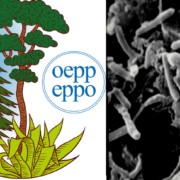Transmission of Xylella fastidiosa to different host plants by naturally infected Philaenus spumarius
Authors: V. Cavalieri, D. Cornara, C. Dongiovanni, G. Altamura, D. Boscia, F. Porcelli, D. Bosco, M. Saponari
Type of contribution: Conference Abstract | Oral Presentation
Conference: 22th Congress of the Italian Society of Plant Pathology, 19-22 September 2016, Roma (Italy)
Keywords: Xylella fastidiosa, Philaenus spumarius, Vectors
Corresponding author: V. Cavalieri (CNR-IPSP)
Abstract
The meadow spittlebug Philaenus spumarius (Hemiptera, Aphrophoridae) has been identified as a vector of Xylella fastidiosa (Xf) in southern Italy where the bacterium has established in the Salentinian Peninsula. This species is one of the most common potential vectors in Europe, but limited information is available on spittlebugs as vectors of Xf. In this work, eleven transmission experiments were performed in 2015 from late spring to late autumn, when adult spittlebugs were present in the Xf-infected olive groves.
Insects were collected by sweeping net on the olive canopies of two selected Xf-infected olive groves and transferred in groups of five on to the following recipient plants: olive, oleander, citrus, grapevine, GF677 (Prunus persica x Prunus amygdalus) and periwinkle. Following an inoculation access period (IAP) of 7-days, the insects were recovered from the cages in order to estimate i) the survival rates ii) the presence of Xf by real-time qPCR in single insects. Transmissions were determined by testing with qPCR the recipient plants.
The results showed that the proportion of P. spumarius that tested positive for Xf ranged from 25 to 71%. P. spumarius transmitted Xf to all the recipient plants except grapevine; however, citrus and stone fruit plants were not systemically infected. More than 75% of the insects survived the 7-day IAP on olive, grapevine, GF677 and periwinkle. A lower survival rate was recorded on citrus and on oleander. These data show that field-collected P. spumarius in the Salentinian olive groves have high rates of X. fastidiosa and are able to transmit the bacterium to different hosts.








